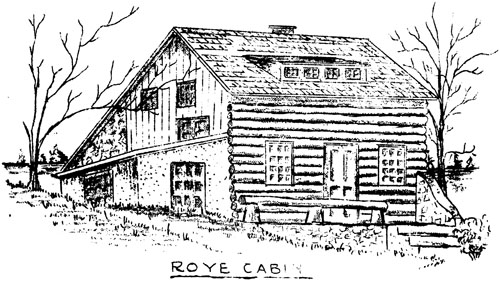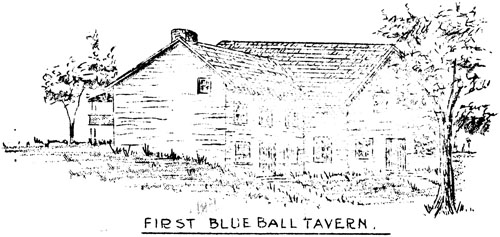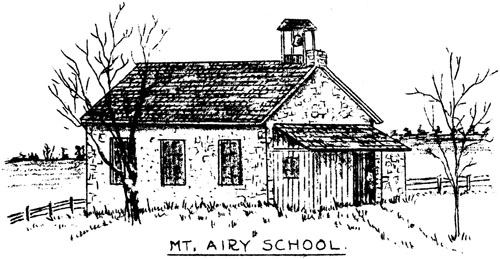|
Home : Quarterly Archives : Volume 8 |
Tredyffrin Easttown Historical Society |
|
Source: April 1955 Volume 8 Number 3, Pages 71–77 Notes on Daylesford The history of Daylesford might be presented in two periods: the first from the early 18th century when the log cabin down the hill to the north of Old Lancaster Road was built by a Welsh farmer in 1714, through the days of the Blue Ball Inns, the Revolution, and the building of the Pennsylvania Railroad in 1832; the second from 1890, when the community was given its name of Daylesford, and the first of the present inhabitants came to live in this immediate vicinity. The earliest recorded house within the boundaries of Daylesford seems to be the log cabin now occupied by Fred Roye built well north of Lancaster Road in 1714, and lived in by a succession of families, including the Heyburns, and the George Clarkes. It is hard to understand the choice of a location so far from what was even then a well-traveled road. The house must have been almost inaccessible in winter, and probably well mired-in during the spring thaws and autumn rains. The cabin still stands, with additions, and one of the most interesting features is the cave for vegetables and other foods. The large fireplace in the old kitchen was for many years blocked up, while a stove kept the family warm, and a lean-to kitchen was added.
Roye Cabin Probably the next house to be built in Daylesford was the first of the Blue Ball Inns, now the home of Miss Caroline Newton, on Glen Road, south of Lancaster Pike. It was a noted tavern during much of the 18th century, and owed a large part of its trade to the fact that it was a comfortable day's horseback ride from Philadelphia. It was also called Half-Way House because of its position half-way between the Brandywine and Schuylkill Rivers, and, more importantly to us, half-way between the old churches of the two Welsh congregations, St. Davids in Devon and St. Peter's in the Great Valley. At one time the same pastor served the two churches, and after the morning service at St. Davids he would ride to the Half- Way House for his midday dinner, then continue to St. Peter's for his afternoon service. In 1741, when a survey was made of the highway, this inn was mentioned as being 18 miles, 3 quarters, and 62 perches west of the Philadelphia Court House. The earliest owner noted was Robert Richardson from 1735 to 1741. In 1741, Thomas McKean, uncle of the Governor, was granted a license at the sign of the Blue Ball. In 1752, Conrad Young, a German, changed the name to the King of Prussia, perhaps hoping to steal trade from the other inn of that name, but after two years it again became the Blue Ball Inn. During the French and Indian Wars, the forces under Generals Forbes and Stanwix were assembled here prior to their march to the Ohio River. The huge stable, now still standing though of course vastly altered, was noted as having doorways high enough so that His Majesty's soldiers could ride in and out without dismounting. The original walls, 18 to 24 inches thick, and the old crossbeams, are still to be seen. The old Blue Ball Inn was in 1758 the office of the appraiser of supplies for the French and Indian Wars, and a record of 1777 shows losses claimed by Captain Thomas Reese after the Inn was plundered by the British. Could this Captain Reese be a member of the family for which Reeseville, later Berwyn, was named? In 1762, Benjamin Weatherby states in his petition for a license at the Sign of the Blue Ball that "it has been a public-house these 70 years past," which would take us back farther than is shown in the records at the Chester County Historical Society. Apparently his widow, Hannah Weatherby, was the applicant in 1766; Philip Eppright held the license from 1771 to 1776, when it lapsed for several years, no doubt for very good cause if one notes the date.
First Blue Ball Tavern When the new Lancaster Turnpike was built, further to the north,the old Blue Ball Inn was left inaccessible, cut off from the flow of traffic, so about 1795 a second tavern was built on the new road, just north of the present Daylesford Station, on the north side of Old Lancaster Road. This was considered a low-class tavern according to Mrs. John Croasdale, and was probably a peddlers' stand. The huge fireplace and stone doorsills may still be seen, and there was a public pump to the east of the house. The ground was included in the original Penn grant. This house is now owned by Mr. Paul McC. Warner. In the orchard of this second Blue Ball, and under the dirt floor, were found several skeletons said to be those of men killed and robbed while asleep in the tavern during the ownership of the notorious Mrs. Prissy Robinson. The aura of mystery and drama surrounding this Inn was furthered by the reputation of Mrs. Robinson, who died here at the age of one hundred in 1877. At the inquest held on one old peddler who died rather suddenly, Prissy testified that she couldn't help it if a wine barrel fell on him while asleep! Priscilla Robinson's mother had been keeper of the first Blue Ball, but the new inn was apparently never licensed, as rejections and disallows followed one after the other, no matter how plaintive the petition. One application was signed by eighty-four "friends and inhabitants", that too was rejected even though it wistfully noted that there was no other public-house nearer than one mile from her house! Prissy's character may be seen from two well-authenticated anecdotes. When the Pennsylvania Railroad built the through-way past her Inn in 1832, she killed a pig, rendered the carcass, and with the fat carefully greased the rails, as a protest against this new device which carried possible customers past her house! The trains were stalled for some time on the slippery upgrade tracks, and no doubt some of the passengers partook of her hospitality at that time. Prissy is said to have told the undertaker that when her time came for burying, she wanted her coffin made of chestnut so she could "go through Hell a-popping!". Mrs. Prissy Robinson was three times married, but used the name of her first husband even on her gravestone. As well as the two old inns at Daylesford, there were two old schools, one taught by Gilbert Wayne and attended by his famous nephew Anthony Wayne, and the other Mt. Airy School. The Wayne School was torn down in the 1880's, some thirty years after its use as a school was made unnecessary by the building of the Mt. Airy School on the north side of the railroad. In 1895 this later building was also demolished, and great relief was felt, as it had been closed for some years and had become but a refuge for tramps. It was on Old Lancaster Pike, just east of the house built in 1893 by the Burwells, the first of the present-day settlers in Daylesford. The Burwell house, as did several others on the other side of the railroad, boasted a large windmill, and these made a clanking, squeaking chorus audible far and wide.
Mt. Airy School The position of the Mt. Airy School, in a very sparsely settled area, might raise the question why not a school in the towns of Paoli and Berwyn? On thinking over the situation then, it seems that Daylesford could have been chosen as a half-way place between the two more populated towns, as certainly in the 1800's a mile walk at the beginning and ending of the school day was thought no handicap, in spite of a child's chores at home to fill the time before dark. In 1890, a news item appeared in the Coatesville Weekly Times, noting the building of a station at Daylesford, on the Pennsylvania Railroad. The naming of this station came about through the interest in Warren Hastings of Mr. Graham, who then lived in the old Blue Ball and owned a large amount of land in Daylesford and Paoli. The Pennsylvania Railroad had produced several horrid choices which Mr. Graham deplored, so he was asked to choose a name himself and to send it in within twenty-four hours. He was at the time deep in a history of the famous trial of Warren Hastings whose family estate at Daylesford, England, figured in the account. Mr. Graham suggested that name, it was accepted, and appeared for the first time in a railroad guide of 1893. In 1899 the second Blue Ball Inn was bought by John Croasdale, and his cousin Olney Croasdale shared it with him, and built the stables to the west where John Croasdale Junior now lives. In 1900 Mr. Olney Croasdale owned the first automobile on the Main Line - that was fame! When Mr. Croasdale married in 1905, ho built "Flambards" which has changed hands several times since his death in 1933. In 1902, he bought from Mr. Graham the first Blue Ball Inn, and there his sister Miss Emily Croasdale lived with their aunt Miss Estelle Fagan until their deaths. The lovely old part of the house has been added to several times and, though it now looks nothing like its original self, a great deal of charm remains, and the huge old fireplace is still a pleasant feature in the main room.
Newton Library In 1894, Daylesford's most prominent citizen, Alfred Edward Newton, bought his first half-acre here, south of Lancaster Pike, and built a six-room house with the proceeds of his first book sale. ($2700; the sale of his library at his death netted several millions). Alfred E. Newton's books about books and the book-collections game brought many well known writers and publishers to his home, Oak Knoll, at Daylesford. Mr. Newton's house grew in all directions with pleasant ambling additions every few years, and soon became a happy gathering-place for celebrities. Here at Daylesford, Mr. Newton was noted for his eccentricities as well as for his books, but he is owed a real debt for the way he awakened interest in Thomas Hardy, Samuel Johnson, Anthony Trollope, William Blake, and others. His essay "Change Cars at Paoli" was a great help in Dr. Burke's campaign for funds to establish a memorial chapel and Museum at Valley Forge. Mr. Newton's charm, expert knowledge, wide circle of friends, as well as his gift for rousing enthusiasm in others, made him an important figure in the literary and academic world, so that on his death in 1940 he was honored in a unique manner, by a memorial booklet published by the Library of Congress, and sent to his many friends. His daughter, Miss Caroline Newton, the present owner of the old Blue Ball Inn, has carried on her father's hospitable tradition, and many well known people have here been her quests: Thomas Mann, W. H. Auden, Glenway Westcott, Dorothy Thompsorn, and others. The lovely and historic first Blue Ball Inn, now called "The Maypole," will not disappear from the Daylesford scene, as Miss Newton has made arrangements so that at her death it will, with the grounds at Oak Knoll, become the property of the three colleges, Haverford, Swarthmore, and Bryn Mawr. Of special interest to the History Club should be the only school at Daylesford since the closing of the old Mt. Airy School. This was held about forty years ago in the History Club's oven tiny clubhouse, and was taught by Agnes Okie for the five years of its existence. Daylesford's only newspaper also has a link with the History Club, as in one of the very first issues was a social note on the trip of Club members to Williamsburg. This weekly was printed by "the children of Daylesford" in the late thirties, and had a circulation of twenty copies, now collectors items, surely! Two pleasant customs firmly established in Daylesford are the lovely out-of-doors carolling on Christmas Eve at the foundations of Oak Knoll, and the large and lively July Fourth celebration at the Kneass place. The latter has been held for thirty years, with several hundred of all ages picnicking on the lawn, and after the fireworks joining the community singing, or viewing the current art show on the porch. Daylesford has always been a simple community, with almost no commercial properties, and only two really large estates, those of Mr. Newton and Mr. A. J. Cassatt. The former house has been torn down, and the latter now houses a chapter of the Norbertine fathers, while on the grounds of both are several smaller homes. The few residents of Daylesford always considered the small size of their community one of its charms, but now the population is multiplying rapidly with the building of many houses on the old Tredyffrin Golf Course, and a like situation on the north side of the railroad. Recognizing the problems attending such fast growth, a Daylesford Civic Association is being formed, and there are hopes that such an organization may help to keep Daylesford the country community it has been through all its pleasant life. |



